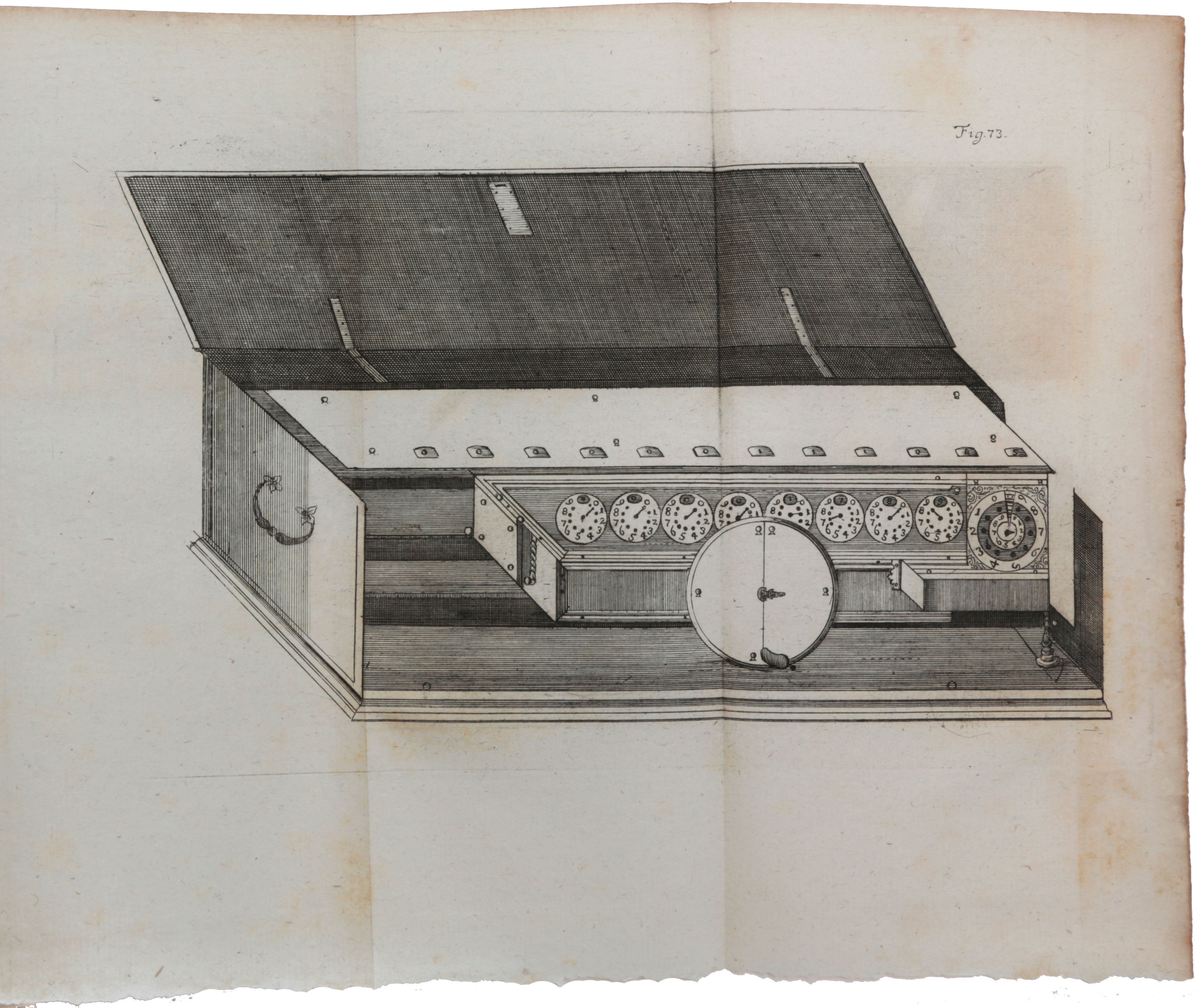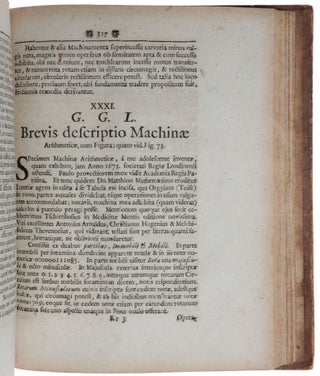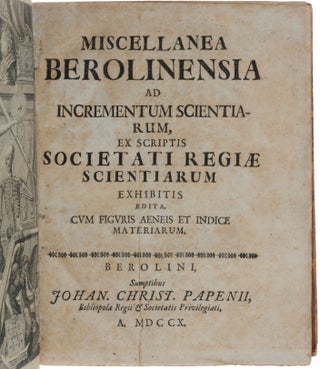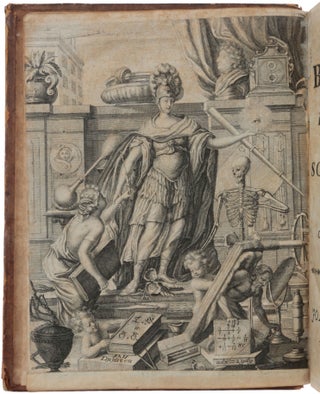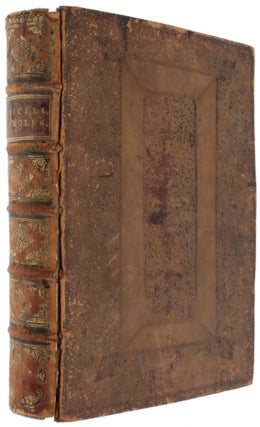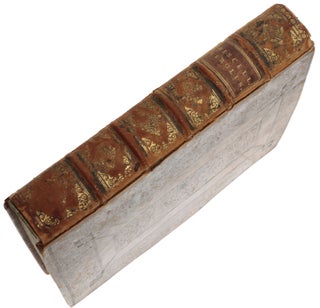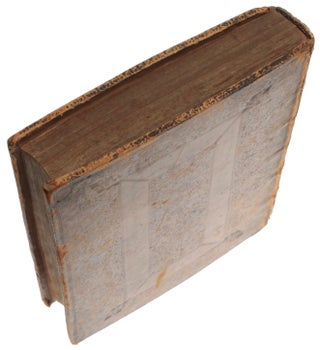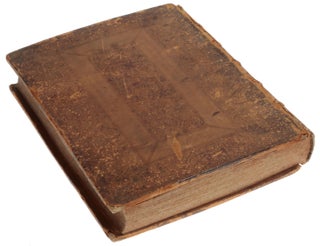Brevis descriptio machinae arithmeticae, cum figura.
Berlin: Johann Christian Papen, 1710. First edition, the Macclesfield copy, of this milestone in computer history, Leibniz’s description of his famous calculating machine, the first stepped-drum calculator, and the first machine that could perform multiplication and division. “Leibniz studied Morland’s and Pascal’s various designs and set himself the task of constructing a more perfect and efficient machine. To begin with, he improved Pascal’s device by adding a stepped-cylinder to represent the digits 1 through 9 … In 1694, Leibniz built his calculating machine, which was far superior to Pascal’s and was the first general purpose calculating device able to meet the major needs of mathematicians and bookkeepers” (Rosenberg, The Computer Prophets, p 48). “[He] invented a device now known as the Leibniz wheel and still in use in some machines. The mechanism enabled him to build a machine which surpassed Pascal’s in that it could do not only addition and subtraction fully automatically but also multiplication and division. Leibniz’s device enabled his machine to perform the operation of multiplication automatically by repeated additions. His idea was apparently re-invented in 1820 by Charles Xavier de Colmar” (Goldstine, The Computer from Pascal to Neumann, p. 7). Although Leibniz demonstrated his machine before the Royal Society and elsewhere, no description of it appeared in print until in the present form. It is contained in the first volume of the journal of the Berlin Academy of Science, which Leibniz founded. “This volume is a collection of papers, mainly by Leibniz, including the description of his calculating machine. The engraving of the machine is not exact. A great deal of artistic license has been used in order to show some of the dials and the top of the machine uncluttered by the human-assisted carry mechanism. Thirteen years after this publication, the first of the continuations of this title were issued when it was adopted as the title for the official journal of the Royal Prussian Academy of Science. The volume also contains a plate showing two Japanese men engaged in a game of Go (a game more complex than chess, played with black and white counters called stones). It is noteworthy that the details of the game had reached Europe by the end of the eighteenth century … The lower part of the frontispiece shows a tiny model of Leibniz’s calculator and two bits of text associated with Leibniz: one a series summing to π/4 (1 – 1/3 + 1/5 – 1/7 + etc., discovered by Leibniz in 1674) and the other an expression from calculus (a dx = 2y dy)” (Tomash & Williams, L69). Although the volume is naturally present in some institutional holdings, it is absent from many, and is rare on the market. It contains several other important papers by Leibniz on mathematics and physics, including the Symbolism memorabilis calculi algebraici et infinitesimalis ... et de lege homogeneousorum transcendentali (p. 160-165), his essay on gravitation, Construction problematis ducendi rectas quae tangunt lineas centrorum gravitatis (pp. 170-173), and his work Historia inventionis Phosphori (pp. 91-98) on the discovery of phosphorus (see Ravier for a full list). Provenance: The Earls of Macclesfield (bookplate to front paste-down and embossed stamp to first three leaves); sold Sotheby’s, 25 October 2005, lot 2188 (£8,400 = $14, 825). “In 1673 German mathematician and philosopher Gottfried Wilhelm Leibniz made a drawing of his calculating machine mechanism. Using a stepped drum, the Leibniz ‘Stepped Reckoner’, mechanized multiplication as well as addition by performing repetitive additions. The stepped-drum gear, or ‘Leibniz Wheel’, was the only workable solution to certain calculating machine problems until about 1875. The technology remained in use through the early 1970s in the Curta hand-held calculator. Leibniz first published a brief illustrated description of his machine in ‘Brevis descriptio machinae arithmeticae, cum figura. . . ,’ Miscellanea Berolensia ad incrementum scientiarum (1710), 317-19. The lower portion of the frontispiece of the journal volume also shows a tiny model of Leibniz’s calculator. Because Leibniz had only a wooden model and two working metal examples of the machine made, one of which was lost, his invention of the stepped reckoner was primarily known through the 1710 paper and other publications. Nevertheless, the machine became well-enough known to have great influence. “Leibniz conceived the idea of a calculating machine in the early 1670s with the aim of improving upon Blaise Pascal's calculator, the Pascaline. He concentrated on expanding Pascal’s mechanism so it could multiply and divide. The first recorded indirect reference is in a letter from the French mathematician Pierre de Carcavy dated June 20, 1671 in which Pascal’s machine is referred to as “la machine du temps passé.” Leibniz demonstrated a wooden model of his calculator at the Royal Society of London on February 1, 1673, though the machine could not yet perform multiplication and division automatically. In a letter of March 26, 1673 to Johann Friedrich, where he mentioned the presentation in London, Leibniz described the purpose of the ‘arithmetic machine’ as making calculations “leicht, geschwind, gewiß” [sic], i.e., easy, fast, and reliable. Leibniz also added that theoretically the numbers calculated might be as large as desired, if the size of the machine was adjusted: “eine zahl von einer ganzen Reihe Ziphern, sie sey so lang sie wolle (nach proportion der größe der Maschine)” (“a number consisting of a series of figures, as long as it may be in proportion to the size of the machine”). “On July 14, 1674, Leibniz informed Henry Oldenburg, secretary of the Royal Society, that a new model had "at last been successfully completed" and was able to “produce a multiplication by making a few turns of a particular wheel, without any effort.” The letter also refers to his good fortune in being able to entrust the work to the Parisian craftsman and clockmaker Olivier (or Ollivier: his first name does not seem to be known), ‘a man who preferred fame to fortune’ (quoted in M.R. Antognazzi. Leibniz: an intellectual biography [2009]). Leibniz showed off an improved version of the calculating machine at the Académie Royale des Sciences in Paris on January 9, 1675, and on his final departure from Paris on October 4, 1676 took a further improved model to show Oldenburg in London. “After Leibniz’s departure, work on the calculating machine continued under the supervision of his Danish friend Friedrich Adolf Hansen (1652-1711), and Leibniz continued to correspond with Olivier. The Leibniz archive includes three letters from Olivier, dated March 24 and July 29, 1677 and November 15, 1678; indeed Leibniz seems to have had some effort made to have Olivier called to Hanover to continue his work. After about 1678 work on the machine seems to have lapsed until Leibniz began to develop a new prototype in the early 1690s. At some point Leibniz’s wooden model and his first metal machine were lost. The second machine, which was built from 1690 to 1720, is preserved in the Niedersächsische Landesbibliothek, Hanover” (historyofinformation.com). This Hanover machine “is about 67 cm (26 inches) long, made of polished brass and steel, mounted in an oak case. It consists of two attached parallel parts: an accumulator section to the rear, which can hold 16 decimal digits, and an 8-digit input section to the front. The input section has 8 dials with knobs to set the operand number, a telephone-like dial to the right to set the multiplier digit, and a crank on the front to perform the calculation. The result appears in the 16 windows on the rear accumulator section. The input section is mounted on rails and can be moved along the accumulator section with a crank on the left end that turns a worm gear, to change the alignment of operand digits with accumulator digits. There is also a tens-carry indicator and a control to set the machine to zero. The machine can: add or subtract an 8-digit number to/from a 16-digit number, multiply two 8-digit numbers to get a 16-digit result, divide a 16-digit number by an 8-digit divisor. “Addition or subtraction is performed in a single step, with a turn of the crank. Multiplication and division are performed digit by digit on the multiplier or divisor digits, in a procedure equivalent to the familiar long multiplication and long division procedures taught in school. Sequences of these operations can be performed on the number in the accumulator; for example, it can calculate roots by a series of divisions and additions” (Wikipedia). “On May 21, 2014 Christie’s in London auctioned Leibniz’s autograph draft contract between Leibniz’s friend Adolf Hansen, acting on Leibniz’s behalf and the clockmaker Olivier in Paris, for the construction of Leibniz’s calculating machine. The 3.5 page contract written by Leibniz in French consisted of 20 numbered articles with some details of payments left blank. The contract was undated but Christie’s assigned to it the date of circa 1677” (historyofinformation.com). “The contract comprises 20 meticulously detailed clauses, describing in detail the machine and the financial and practical arrangements for its construction: it is to produce numbers up to three figures; it is to be capable of multiplication and division, as well as addition and subtraction, with the mechanism (consisting of a system of fixed and mobile pieces, and equal and unequal cogs) described in detail, first for multiplication and division, then for addition and subtraction, noting that the operations should be effected immediately ‘et non pas comme dans la machine du temps passé après un delay ou intervalle’; the machine is to be perfectly finished, made of iron or steel, and enclosed in ‘une petite boëtte propre, à fin qu’il ne paroisse que ce qu’il faut pour l’opération’; the operation of the machine is then specified. The contract goes on to note that Olivier had previously agreed to construct such a machine in one or two months for a payment of ‘cent écus blancs ou trois cens francs’, part of which has been advanced, but that he had failed (in part because of illness) to give satisfaction; he now engages to complete the work in three months, with his goods as surety; and he is to show the progress of his work to Hansen, and inform Leibniz by letter, each week” (Catalogue of Valuable Manuscripts and Printed Books, Sale 1550, Christie’s, King Street, London, 21 May 2014). Leibniz’s paper in the first volume of the Miscellanea Berolinensia is here accompanied by the next four volumes (of a total of seven) published under that title: Continuatio I (Berlin: Papen, 1723) Continuatio II (Berlin: Haude, 1727) Continuatio III (Berlin: Rüdiger, 1734) Continuatio IV (Berlin: Halle, Saale, Renger, 1737) and by the first volume of the successor to the Miscellanea, Histoire de l'Académie royale des Sciences et des lettres de Berlin, année 1745 (Berlin: Haude, 1746). These additional volumes comprise articles on literature, mathematics, mechanics, astronomy, geography, etc., and include contributions by the astronomers Johann Wilhelm Wagner, Johann Philipp von Wurzelbauer, and Christfried Kirch, the mathematicians Chrisoph Langhansen, Jakob Hermann, Jean Baptiste Clairaut and Philippe Naudé the younger, and many others. Ravier 305; Parkinson, Breakthroughs, p. 113.
4to (210 x 165 mm), pp. [xxiv, including frontispiece], 394, with engraved allegorical frontispiece, and 31 folding engraved plates (some browning to the first and last leaves, but less than is usual with this book). Contemporary paneled calf, spine richly gilt in compartments with lettering-piece (rubbed, joints cracked but firm, minor loss to ends of spine).
Item #5781
Price: $35,000.00

